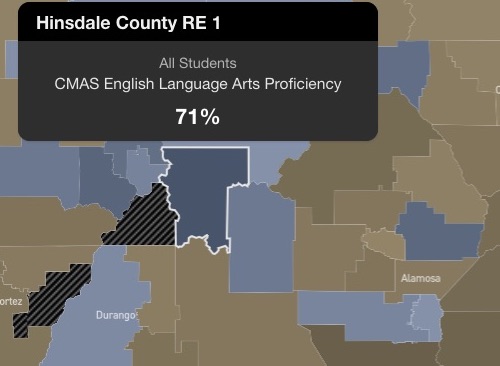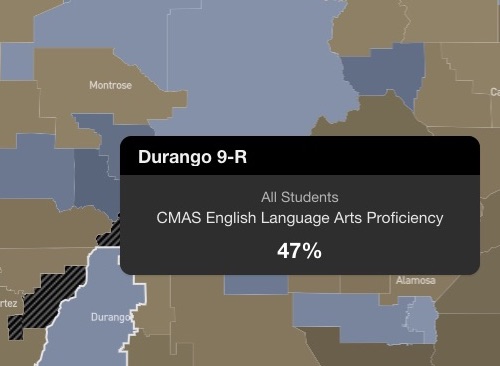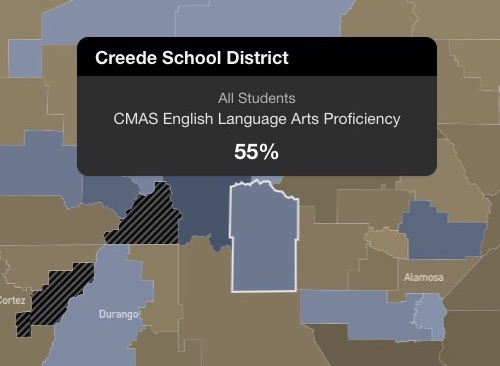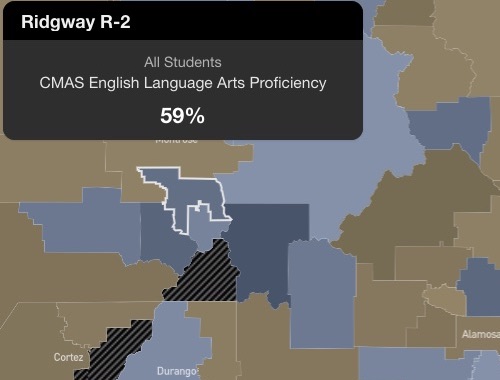As I mentioned yesterday in Part Two, I had a chance to sit down over coffee with Archuleta School District (ASD) board president Bob Lynch and discuss CMAS test scores, and also the increased interest, in Pagosa Springs, in improving and expanding our ‘CTE’ offerings.
‘Career and Technical Education’.
A few of Mr. Lynch’s comments:
“Personally — and I’m not speaking for the rest of the Board — I feel really good about the leadership that we have at the schools; the Superintendent, the building leaders, the principals, and the great educators we have in the system. We have the people in place to continuously improve our academic performances in the traditional areas we look at, such as the CMAS tests…”
The Colorado Measures of Academic Success tests. The state’s required standardized tests.
“We saw some bump-ups, and from what we hear from the leadership teams, that improvement should continue over the next several years…”
I asked if he would relate the District’s desire for good CMAS scores — in reading, writing, and mathematics — with the increased focus, in Colorado, on career and technical education. ‘CTE’.
“In my mind, there’s a foundation of academic skills that everyone needs throughout their life, and with that foundation, what we can do now is apply that knowledge, and make it more interesting by applying it to a wider range of areas that include career and technical education. It’s a great time in education, when almost everyone from students to parents to the whole community sees the need for kids to apply their knowledge to a field that they might pursue, that doesn’t necessarily involve going to college. It might involve college, but it might involve a career, and it’s important to start learning about those choices as early as possible, so that the choices are wider.
“We have several offerings in career and technical, today — building trades, automotive, culinary, health care — and there are opportunities to widely expand that, through our partnership with Build Pagosa and other things we might be able to do as a District.
“But it’s a huge opportunity, and it’s a way to keep kids engaged and make learning more interesting and fun, when you pick something you really like — maybe automotive, or building a building — and apply some of those academic skills that we consider a little drier, and apply them to something that really interests you.
“My idea is, the wider the choices, the better. On the one hand, we want more choices in career and technical education; on the other hand, we want academic success so you don’t get ruled out of college, if you decide to take that path. Solid academics just widens your choices.
“Kids should be skilled in the fundamentals, and then pick things they’re interested in. I was at the elementary school last year, and I asked some kids what they wanted to be when they grew up. One wants to be a diesel mechanic, and another one wants to be a YouTube influencer. So there’s a big range there…”
I agree with much of what Mr. Lynch says. There is indeed a big range in the ways our children and grandchildren will construct their lives over the next several decades. And I hope that, here in Pagosa Springs, we want to honor that big range as best we can.
I fear the Colorado Department of Education has painted themselves into a corner that hampers them from honoring that big range.
As was mentioned in Part One, ASD’s scores on the CMAS and SAT tests, as shared by the Pagosa Springs SUN newspaper, were not impressive, compared to nearby school districts or the Colorado state averages. The scores show the percentage of students that ‘met or exceeded’ the proficiency levels expected by Colorado Department of Education (CDE) experts.
CMAS results: Percent of students who met or exceeded expectations.
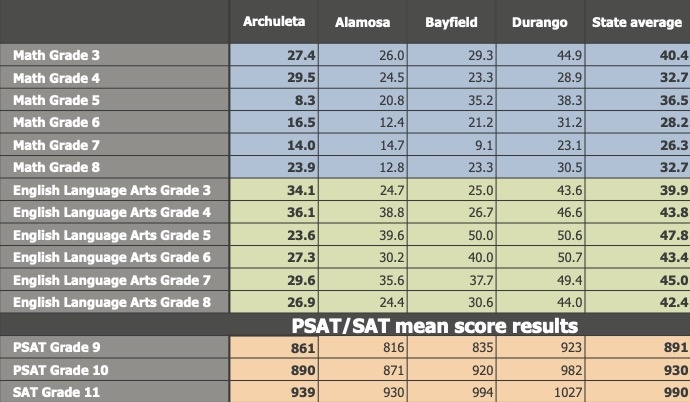
Obviously, ASD has room for improvement.
I’m hoping to share thoughts from other ASD leaders later in this article series. But in the meantime, I can share some interesting information. (At least, I personally find it interesting.)
Disclosure: I currently serve as a volunteer on the Pagosa Peak Open School board of directors, but this editorial series reflects only my own personal opinions, and not necessarily those of the PPOS board as a whole.
School districts in Colorado are required to track family income levels, to qualify students living in low-income households for the federal ‘Free and Reduced Lunch’ (FRL) program, which relates to federal subsidies for students living in relative poverty. Here are the numbers for 2022, for some southwest Colorado school districts, as published by CDE.
- Archuleta School District 51% FRL
- Ignacio School District 69% FRL
- Hinsdale School District 35% FRL
- Durango School District 31% FRL
- Creede School District 42% FRL
- Ridgway School District 17% FRL.
A bit of a range, we might say, in the amount of family poverty in various communities in our region.
We also see a bit of a range in the district CMAS scores for English Language Arts Proficiency. Here are some numbers, for those same six southwestern districts, from an interactive map published by the Colorado Sun news website, averaging the ‘Proficiency’ scores for all students in grades 3 through 8.
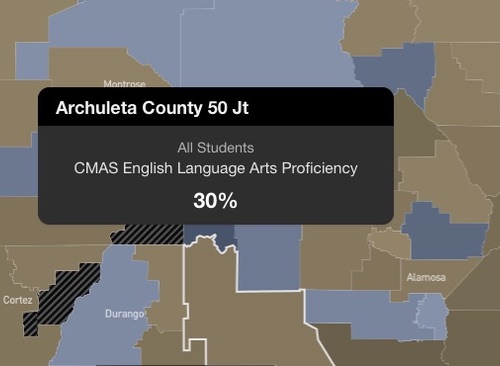
Clearly, some school districts in southwest Colorado are achieving much higher levels of ‘Proficiency’ on the CMAS English language tests, than other districts. Why would that be? Aren’t public schools operated in pretty much the same way everywhere, and funded at pretty much the same levels?
How can we explain an average ‘Proficiency’ range from 25% to 71%? Are some school districts seriously falling down on the job?
I don’t believe that’s the case.
We could, if we were so inclined, compare the percentage of students who are NOT ‘Proficient’ in English Language Arts, with the percentage of students who are living in relative poverty.
Archuleta School District
Percentage NOT proficient in ELA: 70%
Percentage living in relative poverty: 51%
Ignacio School District
Percentage NOT proficient in ELA: 75%
Percentage living in relative poverty: 69%
Hindale School District
Percentage NOT proficient in ELA: 29%
Percentage living in relative poverty: 35%
Durango School District
Percentage NOT proficient in ELA: 53%
Percentage living in relative poverty: 31%
Creede School District
Percentage NOT proficient in ELA: 45%
Percentage living in relative poverty: 42%
Ridgway School District
Percentage NOT proficient in ELA: 41%
Percentage living in relative poverty: 17%
For most of these communities, the correlation between children living in relative poverty and children NOT ‘Proficient’ as measured by the CMAS test is within 20 percentage points. In Creede, it’s nearly a perfect match. The mismatch in Archuleta is 19 percentage points; the mismatch in Ridgway is 24 percentage points.
Essentially — if we accept these statistics as representative — the more affluent your community, the better chance your school district has of achieving ‘Proficient’ CMAS scores. It would seem that the simplest way to improve your district’s CMAS ranking is to attract wealthy families, with children.
In my humble opinion, the CMAS test scores do not measure the potential of our students to succeed in life. I believe what the CMAS tests measure is, basically, which children live in relative poverty, compared to the state as a whole. I believe the CMAS tests measure, primarily, how closely a family’s cultural values and life experiences align with the values and experiences of the folks who run our education system.
Many of the people working in the Archuleta School District acknowledge that the test-score disparities appear correlated to family income, but will tell you that our District is not limited by that correlation. They will insist that every child can potentially achieve a decent CMAS score, if we can just find the right educational techniques and curriculum, and if we can just hire the right teachers and school professionals.
The implication, if we follow that logic, is that CMAS is a perfectly good measuring device, and the Archuleta School District is currently performing poorly at its primary task, compared to many Colorado school districts.


